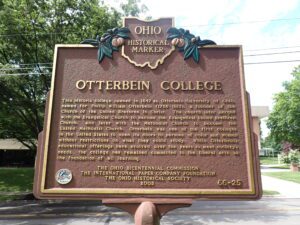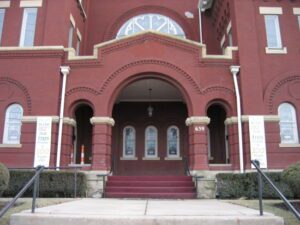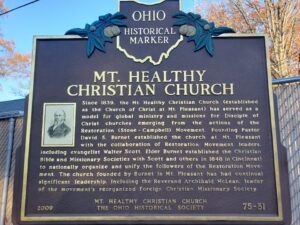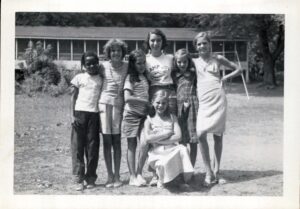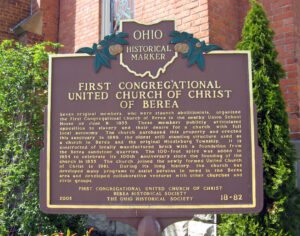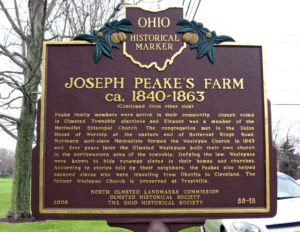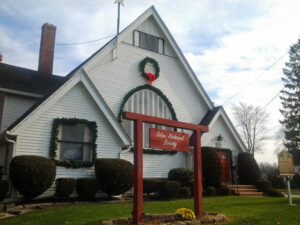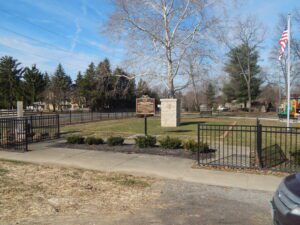, OH
This historic college opened in 1847 as Otterbein University of Ohio, named for Philip William Otterbein (1726-1813), a founder of the Church of the United Brethren in Christ. The church later merged with the Evangelical Church to become the Evangelical United Brethren Church, and later with the Methodist Church to become the United Methodist Church. Otterbein was one of the first colleges in the United States to open its doors to persons of color and women without restrictions on what they could study. While Otterbein’s educational offerings have evolved over the years to meet society’s needs, the college has remained committed to the liberal arts as the foundation of all learning.
, OH
Organized in 1823 as Bethel African Methodist Episcopal Church, St. Paul A.M.E. Church is the oldest congregation of African descent in Columbus. The church, founded by Moses Freeman and 13 other members from the Town Street Church, was originally located on the east side of Lazelle Street. Several buildings were erected to meet the needs of the growing congregation. The present edifice, located at 639 E. Long Street, was completed in 1906. St. Paul has several outreach ministries, including The Prison Ministry, Alzheimer Ministry, Karen’s House, Community Development Corporation, Health Concerns Committee, St. Paul Tutorial and Enrichment Program (STEP), St. Paul Scholarship Program, St. Paul Drama Ministry, Jam’N Jefferson Park Festival, and Church Without Walls.
, OH
Since 1839, the Mt. Healthy Christian Church (established as the Church of Christ at Mt. Pleasant) has served as a model for global ministry and missions for Disciple of Christ churches emerging from the actions of the Restoration (Stone-Campbell) Movement. Founding Pastor David S. Burnet established the church at Mt. Pleasant with the collaboration of Restoration Movement leaders, including evangelist Walter Scott. Elder Burnet established the Christian Bible and Missionary Societies with Scott and others in 1848 in Cincinnati to nationally organize and unify the followers of the Restoration Movement. The church founded by Burnet in Mt. Pleasant has had continual significant leadership, including the Reverend Archibald McLean, leader of the movement’s reorganized Foreign Christian Missionary Society.
, OH
Camp Joy was born at the site of Seven Hills Neighborhood House and original location of St. Barnabas Episcopal Mission Church. Displacement and loss caused by Ohio River flood of 1937 inspired St. Barnabas’ rector and his wife, Laurence “Cap” and Sadie Hall, to act on behalf of the children of Cincinnati’s West End. The Halls conceived of Camp Joy as a haven where kids could find a respite from impoverished surroundings in the city and its sweltering summer heat. The camp was a success and continued after the Halls’ assignment to another parish. From 1940-1944, Rev J. Brooke and Mrs. Betty Mosley continued to nurture the people of the West End through St. Barnabas and Camp Joy. (Continued on other side)
, OH
Seven original members, who were staunch abolitionists, organized the First Congregational Church of Berea in the nearby Union School House on June 9, 1855. These members publicly articulated opposition to slavery and their desire for a church with full local autonomy. The church purchased this property and erected this sanctuary in 1869, the oldest still standing structure used as a church in Berea and the original Middleburg Township. It is constructed of locally manufactured brick with a foundation from the Berea sandstone quarries. The 100-foot spire was added in 1954 to celebrate its 100th anniversary since the founding of the church in 1855. The church joined the newly formed United Church of Christ in 1961. During its long history, the church has developed many programs to assist persons in need in the Berea area and developed collaborative ventures with other churches and civic groups.
, OH
Joseph Peake was born in Pennsylvania in 1792 and came to Ohio in 1809 with his parents and brother. They were the first African Americans to settle permanently in the Cleveland area. He was the son of George Peake, a runaway slave from Maryland, who fought on the British side at the Battle of Quebec in 1759 during the French and Indian War. A man with some means and talent, George Peake invented a stone hand mill for grinding corn, a labor-saving device that endeared the Peakes to their neighbors in western Cuyahoga County. Joseph Peake and his wife Eleanor, an African American from Delaware, bought land in the 1840s on the Mastick Plank Road and built a home near this marker. [Continued on other side]
, OH
In 1845, the Disciples of Christ built the first of three churches to occupy this site. They built a second, larger structure, to replace the original in 1858. On August 6th, 1860, 29 year-old circuit minister Brother James A. Garfield, the future 20th President of the United States, was paid $250.00 to speak here every other Sunday for one year. An arsonist destroyed both the second church and the Solon Village Hall. Erected in 1899, this building replaced the second church and was occupied by the Disciples of Christ until 1920, when it merged with two local churches to establish the Federated Church of Solon. In 1951, the Pioneer Memorial Church split from the Federated Church to move into the abandoned Disciples Church, which they renovated. The City of Solon purchased the building in 1968, and it has since been the home of The Solon Historical Society.
, OH
The first Blendon Presbyterian Church was located at the intersection of Dempsey and Hempstead Roads on what is part of Blendon Central Cemetery. Timothy Lee (1785-1862) donated land at the northeast corner for a church and cemetery. The church was dedicated on December 6, 1829, but it burned that same night under suspicious circumstances. Following the fire, the congregation’s members built another edifice on “Phelps Acre,” across Hempstead Road and so named for benefactor Edward Phelps. Sr. (1759-1840). The congregation held services there from 1830 to 1865. It was believed that the church was finally abandoned and dismantled piecemeal after the Central College Presbyterian Church was finished in 1870.


